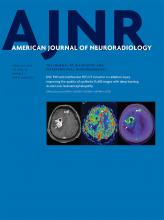Index by author
Coblentz, A.
- FELLOWS' JOURNAL CLUBAdult BrainYou have accessA Deep Learning–Based Approach to Reduce Rescan and Recall Rates in Clinical MRI ExaminationsA. Sreekumari, D. Shanbhag, D. Yeo, T. Foo, J. Pilitsis, J. Polzin, U. Patil, A. Coblentz, A. Kapadia, J. Khinda, A. Boutet, J. Port and I. HancuAmerican Journal of Neuroradiology February 2019, 40 (2) 217-223; DOI: https://doi.org/10.3174/ajnr.A5926
The purpose of this study was to develop a fast, automated method for assessing rescan need in motion-corrupted brain series. A deep learning–based approach was developed, outputting a probability for a series to be clinically useful. Comparison of this per-series probability with a threshold, which can depend on scan indication and reading radiologist, determines whether a series needs to be rescanned. The deep learning classification performance was compared with that of 4 technologists and 5 radiologists in 49 test series with low and moderate motion artifacts. Fast, automated deep learning–based image-quality rating can decrease rescan and recall rates, while rendering them technologist-independent. It was estimated that decreasing rescans and recalls from the technologists' values to the values of deep learning could save hospitals $24,000/scanner/year.
Colosimo, C.
- PediatricsYou have accessBrain DSC MR Perfusion in Children: A Clinical Feasibility Study Using Different Technical Standards of Contrast AdministrationS. Gaudino, M. Martucci, A. Botto, E. Ruberto, E. Leone, A. Infante, A. Ramaglia, M. Caldarelli, P. Frassanito, F.M. Triulzi and C. ColosimoAmerican Journal of Neuroradiology February 2019, 40 (2) 359-365; DOI: https://doi.org/10.3174/ajnr.A5954
Conolly, S.
- Review ArticleOpen AccessA Review of Magnetic Particle Imaging and Perspectives on NeuroimagingL.C. Wu, Y. Zhang, G. Steinberg, H. Qu, S. Huang, M. Cheng, T. Bliss, F. Du, J. Rao, G. Song, L. Pisani, T. Doyle, S. Conolly, K. Krishnan, G. Grant and M. WintermarkAmerican Journal of Neuroradiology February 2019, 40 (2) 206-212; DOI: https://doi.org/10.3174/ajnr.A5896
Damiano, R.J.
- NeurointerventionOpen AccessOstium Ratio and Neck Ratio Could Predict the Outcome of Sidewall Intracranial Aneurysms Treated with Flow DivertersN. Paliwal, V.M. Tutino, H. Shallwani, J.S. Beecher, R.J. Damiano, H.J. Shakir, G.S. Atwal, V.S. Fennell, S.K. Natarajan, E.I. Levy, A.H. Siddiqui, J.M. Davies and H. MengAmerican Journal of Neuroradiology February 2019, 40 (2) 288-294; DOI: https://doi.org/10.3174/ajnr.A5953
Davies, J.
- InterventionalOpen AccessHigh-Definition Zoom Mode, a High-Resolution X-Ray Microscope for Neurointerventional Treatment Procedures: A Blinded-Rater Clinical-Utility StudyS.V. Setlur Nagesh, V. Fennel, J. Krebs, C. Ionita, J. Davies, D.R. Bednarek, M. Mokin, A.H. Siddiqui and S. RudinAmerican Journal of Neuroradiology February 2019, 40 (2) 302-308; DOI: https://doi.org/10.3174/ajnr.A5922
Davies, J.M.
- NeurointerventionOpen AccessOstium Ratio and Neck Ratio Could Predict the Outcome of Sidewall Intracranial Aneurysms Treated with Flow DivertersN. Paliwal, V.M. Tutino, H. Shallwani, J.S. Beecher, R.J. Damiano, H.J. Shakir, G.S. Atwal, V.S. Fennell, S.K. Natarajan, E.I. Levy, A.H. Siddiqui, J.M. Davies and H. MengAmerican Journal of Neuroradiology February 2019, 40 (2) 288-294; DOI: https://doi.org/10.3174/ajnr.A5953
Deschamps, R.
- SpineYou have accessA 3T Phase-Sensitive Inversion Recovery MRI Sequence Improves Detection of Cervical Spinal Cord Lesions and Shows Active Lesions in Patients with Multiple SclerosisA. Fechner, J. Savatovsky, J. El Methni, J.C. Sadik, O. Gout, R. Deschamps, A. Gueguen and A. LeclerAmerican Journal of Neuroradiology February 2019, 40 (2) 370-375; DOI: https://doi.org/10.3174/ajnr.A5941
Diehn, F.E.
- SpineYou have accessRenal Contrast on CT Myelography: Diagnostic Value in Patients with Spontaneous Intracranial HypotensionK.A. Kinsman, J.T. Verdoorn, P.H. Luetmer, M.S. Clark and F.E. DiehnAmerican Journal of Neuroradiology February 2019, 40 (2) 376-381; DOI: https://doi.org/10.3174/ajnr.A5934
Doyle, T.
- Review ArticleOpen AccessA Review of Magnetic Particle Imaging and Perspectives on NeuroimagingL.C. Wu, Y. Zhang, G. Steinberg, H. Qu, S. Huang, M. Cheng, T. Bliss, F. Du, J. Rao, G. Song, L. Pisani, T. Doyle, S. Conolly, K. Krishnan, G. Grant and M. WintermarkAmerican Journal of Neuroradiology February 2019, 40 (2) 206-212; DOI: https://doi.org/10.3174/ajnr.A5896
Dremmen, M.H.G.
- PediatricsOpen AccessCavum Septum Pellucidum in the General Pediatric Population and Its Relation to Surrounding Brain Structure Volumes, Cognitive Function, and Emotional or Behavioral ProblemsM.H.G. Dremmen, R.H. Bouhuis, L.M.E. Blanken, R.L. Muetzel, M.W. Vernooij, H.E. Marroun, V.W.V. Jaddoe, F.C. Verhulst, H. Tiemeier and T. WhiteAmerican Journal of Neuroradiology February 2019, 40 (2) 340-346; DOI: https://doi.org/10.3174/ajnr.A5939








